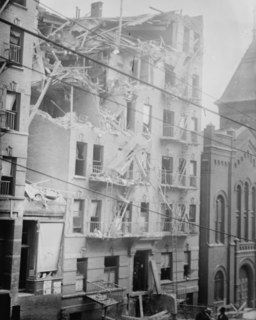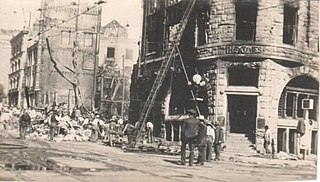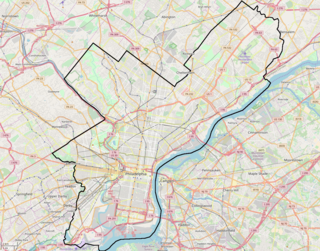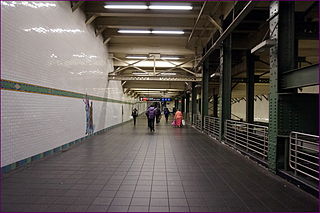 W
WThe 16th Street Baptist Church bombing was a white supremacist terrorist bombing of the 16th Street Baptist Church in Birmingham, Alabama, on Sunday, September 15, 1963. Four members of a local Ku Klux Klan chapter planted 19 sticks of dynamite attached to a timing device beneath the steps located on the east side of the church.
 W
WBombingham is a nickname for Birmingham, Alabama during the Civil Rights Movement due to the 50 dynamite explosions that occurred in the city between 1947 and 1965. The bombings were initially used against African Americans attempting to move into neighborhoods with entirely white residents. Later, the bombings were used against anyone working towards racial desegregation in the city. One neighborhood within Birmingham experienced so many bombings it developed the nickname of Dynamite Hill.
 W
WFraunces Tavern is a museum and restaurant in New York City, situated at 54 Pearl Street at the corner of Broad Street in the Financial District of Lower Manhattan. The location played a prominent role in history before, during, and after the American Revolution. At various points in its history, Fraunces Tavern served as a headquarters for George Washington, a venue for peace negotiations with the British, and housing federal offices in the Early Republic.
 W
WThe Greenwich Village townhouse explosion occurred on March 6, 1970, in New York, New York, United States. Members of the Weather Underground (Weathermen), an American leftist militant group, were making bombs in the basement of 18 West 11th Street in the Greenwich Village neighborhood, when one of them exploded. The resulting series of three blasts completely destroyed the four-story townhouse and severely damaged those adjacent to it, including the then home of actor Dustin Hoffman and theater critic Mel Gussow. Three Weathermen—Ted Gold, Diana Oughton and Terry Robbins—were killed in the blast, while two survivors, Kathy Boudin and Cathy Wilkerson, were helped out of the wreckage and subsequently fled.
 W
WThe Harvey's Resort Hotel bombing took place on August 26–27, 1980, when several men masquerading as photocopier deliverers planted an elaborately booby trapped bomb containing 1,000 pounds (450 kg) of dynamite at Harvey's Resort Hotel in Stateline, Nevada, United States. After an attempt to disarm the bomb, it exploded causing extensive damage to the hotel but no injuries or deaths. The total cost of the damage was estimated to be around $18 million. John Birges Sr. was convicted of having made the bomb with a goal of extorting money from the casino after having lost $750,000 there. He died in prison in 1996, at the age of 74.
 W
WThe Lexington Avenue explosion was the July 4, 1914, explosion of a terrorist bomb in an apartment at 1626 Lexington Avenue in New York City, New York, United States. Members of the Lettish section of the Anarchist Black Cross (ABC) were constructing a bomb in a seven-story tenement when the group's large supply of dynamite exploded prematurely. The blast destroyed most of the top three floors of the building, killing three conspirators and another renter who was not part of the bomb plot, as well as injuring dozens more.
 W
WThe Los Angeles Times bombing was the purposeful dynamiting of the Los Angeles Times Building in Los Angeles, California, on October 1, 1910, by a union member belonging to the International Association of Bridge and Structural Iron Workers. The explosion started a fire which killed 21 newspaper employees and injured 100 more. It was termed the "crime of the century" by the Times.
 W
WThe Milwaukee Police Department bombing was a November 24, 1917, bomb attack that killed ten people including nine members of local law enforcement. The perpetrators were never caught but are suspected to be an anarchist terrorist cell operating in the United States in the early 20th century. The target was initially an evangelical church in the Third Ward and only killed the police members when the bomb was taken to the police station by a concerned member of the public. The bombing remained the most fatal single event in national law enforcement history for over 80 years until the 9-11 attacks.
 W
WThe 1985 MOVE bombing refers to the May 13, 1985, incident in Philadelphia, Pennsylvania, United States, when the Philadelphia Police Department bombed a residential home occupied by the militant black group MOVE, and the Philadelphia Fire Department let the subsequent fire burn out of control following a standoff and firefight. A lawsuit in federal court found that the city used excessive force and violated constitutional rights against unreasonable search and seizure. Sixty-one homes were burned to the ground over two city blocks.
 W
WOn December 25, 2020, Anthony Quinn Warner detonated a recreational vehicle (RV) bomb in downtown Nashville, Tennessee, United States, killing himself, injuring eight people and damaging dozens of buildings in the surrounding area. It took place at 166 Second Avenue North between Church Street and Commerce Street at 6:30 am, adjacent to an AT&T network hub, resulting in days-long communication service outages.
 W
WOn December 11, 2017, a pipe bomb partially detonated in the subway station adjoining the Port Authority Bus Terminal in Midtown Manhattan, New York City, injuring four people including the bomber. Mayor Bill de Blasio described the incident as "an attempted terrorist attack". The bomber was identified by police as 27-year-old Akayed Ullah, a Salafi Muslim immigrant from Bangladesh; he was convicted in 2018 and sentenced to life in prison in 2021.
 W
WThe Oklahoma City bombing was a domestic terrorist truck bombing of the Alfred P. Murrah Federal Building in Oklahoma City, Oklahoma, United States, on Wednesday, April 19, 1995. Perpetrated by anti-government extremists Timothy McVeigh and Terry Nichols, the bombing happened at 9:02 am and killed at least 168 people, injured more than 680 others, and destroyed more than one-third of the building, which had to be demolished. The blast destroyed or damaged 324 other buildings within a 16-block radius, shattered glass in 258 nearby buildings, and destroyed or burned 86 cars, causing an estimated $652 million worth of damage. Local, state, federal, and worldwide agencies engaged in extensive rescue efforts in the wake of the bombing. The Federal Emergency Management Agency (FEMA) activated 11 of its Urban Search and Rescue Task Forces, consisting of 665 rescue workers who assisted in rescue and recovery operations. The Oklahoma City bombing remains the deadliest act of domestic terrorism in U.S. history.
 W
WThe 1989 firebombing of the Riverdale Press was an attack in which two firebombs were thrown at the offices of a weekly newspaper, the Riverdale Press, in the Riverdale community of the Bronx, New York City on February 28, 1989. The building was heavily damaged. Two California bookstores were also damaged in similar attacks.
 W
WThe San Francisco Police Department Park Station bombing occurred on February 16, 1970, when a pipe bomb filled with shrapnel detonated on the ledge of a window at the San Francisco Police Department's Upper Haight Park substation. Brian V. McDonnell, a police sergeant, was fatally wounded in its blast. Robert Fogarty, another police officer, was severely wounded in his face and legs and was partially blinded. In addition, eight other police officers were wounded.
 W
WOn May 1, 2010, a terrorist attack was attempted in Times Square in Manhattan, New York. Two street vendors alerted NYPD after they spotted smoke coming from a vehicle, and a car bomb was discovered. The bomb had been ignited, but failed to explode, and was disarmed before it caused any casualties. Two days later, federal agents arrested Faisal Shahzad, a 30-year-old Pakistan-born resident of Bridgeport, Connecticut, who had become a U.S. citizen in April 2009. He was arrested after he had boarded Emirates Flight 202 to Dubai at John F. Kennedy International Airport. He admitted attempting the car bombing and said that he had trained at a Pakistani terrorist training camp, according to U.S. officials.
 W
WThe 1983 U.S. Senate bombing was a bomb explosion at the United States Senate on November 7, 1983, motivated by United States military involvement in Lebanon and Grenada. The attack led to heightened security in the DC metropolitan area, and the inaccessibility of certain parts of the Senate Building. Six members of the radical far-left Resistance Conspiracy were arrested in May 1988 and charged with the bombing, as well as related bombings of Fort McNair and the Washington Navy Yard which occurred April 25, 1983, and April 20, 1984, respectively.
 W
WThe 1993 World Trade Center bombing was a terrorist attack on the World Trade Center in New York City, carried out on February 26, 1993, when a truck bomb detonated below the North Tower of the complex. The 1,336 lb (606 kg) urea nitrate–hydrogen gas enhanced device was intended to send the North Tower crashing into the South Tower, bringing both towers down and killing tens of thousands of people. It failed to do so, but killed six people, including a pregnant woman, and injured over one thousand. About 50,000 people were evacuated from the buildings that day.